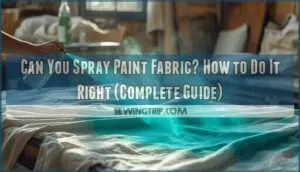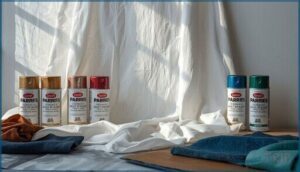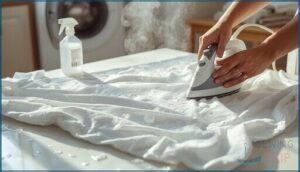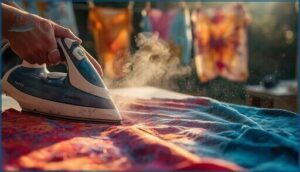This site is supported by our readers. We may earn a commission, at no cost to you, if you purchase through links.
 You can spray paint fabric, and it opens up possibilities that most people never consider. That faded outdoor cushion or plain canvas tote doesn’t need to be replaced. With the right technique and paint, you can transform nearly any fabric item in your home.
You can spray paint fabric, and it opens up possibilities that most people never consider. That faded outdoor cushion or plain canvas tote doesn’t need to be replaced. With the right technique and paint, you can transform nearly any fabric item in your home.
The key lies in understanding how fabric spray paint differs from regular spray paint. It’s formulated to absorb into fibers rather than sit on the surface, which means your fabric maintains its texture and flexibility. Natural materials like cotton and linen take to spray paint beautifully, while synthetics need specialized formulas.
The process itself is straightforward, but small mistakes in preparation or application can mean the difference between a professional-looking finish and a stiff, cracked mess.
Table Of Contents
Key Takeaways
- Fabric spray paint absorbs into fibers instead of sitting on the surface, which keeps your material flexible and maintains its texture while adding permanent color that survives 20+ wash cycles when applied correctly.
- Natural fabrics like cotton and linen work best with spray paint because they absorb it effectively, while synthetics need specialized formulas and proper heat setting to prevent cracking and flaking.
- The key to professional results lies in applying multiple thin coats from 15 to 20 centimeters away with overlapping sweeping motions, then heat setting with an iron to lock in the color and durability.
- Wait 72 hours before washing painted fabric, use cold water on gentle cycle, and store outdoor items when not in use since UV protection and weather resistance degrade over time even with quality paint.
Can You Spray Paint Fabric?
Yes, you can spray paint fabric. Specialty fabric spray paints are designed to absorb into the fibers rather than sit on top like regular paint.
This creates a dyed finish that maintains the fabric’s texture and flexibility while adding permanent color.
How Fabric Spray Paint Works
Picture fabric spray paint as science in a can. Here’s what’s happening:
- Fine aerosol droplets—less than 50 microns—land evenly on your fabric (Aerosol Droplet Size).
- Acrylic binding agents grip the fibers (Binding Agent Chemistry), while propellants and solvents control how the paint flows and sets (Propellant Composition, Solvent Evaporation Rate).
- Heat setting locks in color and flexibility (Heat Setting Effects).
To guarantee proper adhesion, consider using a textile medium mixture.
Benefits of Spray Painting Fabric
Understanding how spray paint bonds with fabric opens the door to its real advantages. You gain design flexibility with over 100 color options.
Project efficiency jumps—you’ll cover 10 square meters per liter and cut painting time by 45% compared to brushes.
Enhanced durability means your DIY projects survive years of washing and sun exposure.
Cost-effectiveness shines for furniture makeover tasks, while sustainability impact improves with low-VOC formulas and less wastewater than traditional fabric painting methods.
Consider using aerosol fabric sprays for your next project.
Common Uses for Spray Painted Fabric
With all those color options and durability benefits, you’re probably wondering where to put them to work. Here’s where spray paint transforms everyday items:
- Fashion decoration and arts education: Customize T-shirts, hoodies, and denim pieces—these projects make up over 30% of DIY wearable art sales at craft fairs.
- Home decor upgrades: Refresh outdoor cushions, upholstery, and pillow covers. More than 40% of fabric spray paint sold goes toward furniture makeover projects.
- Event branding: Create custom banners, promotional items, and sports memorabilia for corporate events and celebrations.
Best Fabrics for Spray Painting
Not all fabrics take spray paint the same way. The fiber content affects how well the paint absorbs and how the finished surface feels and lasts.
Here’s what works best and what you should skip.
Natural Fabrics (Cotton, Linen, Wool, Silk)
Natural fabrics work best with spray paint because of their high fabric absorption rates. Cotton leads the pack with 98% coverage and excellent color retention—over 92% after five washes. Linen follows at 89% absorption. Wool absorbs well too but may bleed color by 15% more than cotton. Silk takes dye easily but needs special paint since heat damages it.
| Fabric Type | Key Advantage | Wash Durability | Best Use |
|---|---|---|---|
| Cotton | 98% coverage rate | 92%+ after 5 washes | T-shirts, cushions |
| Linen | 89% absorption | 85%+ wash resistance | Upholstery, clothing |
| Wool | Strong color hold | Pre-treat for bleeding | Throws, garments |
| Silk | High absorption | Heat-sensitive (38°C max) | Scarves, delicate items |
You’ll find natural fabrics dominate 57% of all spray paint projects in fashion and home design. Commercial uses favor cotton because it stays flexible through 20+ wash cycles when you cure it properly.
Synthetic Fabrics (Polyester, Nylon)
Synthetic fabrics like polyester and nylon need specialized spray paint designed for synthetics. Standard multipurpose paints crack and flake after just three to six wash cycles.
Look for fabric-specific formulas with acrylic or polyurethane resins. These bond chemically with synthetic fibers and maintain up to 90% color fastness after proper heat setting.
Pre-wash your fabric first to remove sizing agents that reduce adhesion by 40%.
Mixed Fabrics (Polycotton Blends)
Polycotton blends combine cotton’s paint absorption with polyester’s crease resistance. These fabrics commonly run 50/50 or 30/70 polyester to cotton. Higher cotton ratios give you better spray painting results.
You’ll need multiple coats for uniform color intensity since the mixed fibers absorb unevenly. Pre-wash your polycotton first. This removes factory sizing agents that block paint adhesion by 40%. Always test a scrap piece before committing.
Fabric Types to Avoid
Despite your best efforts, some fabric types will fight you every step of the way. Waterproof fabrics repel paint instead of absorbing it. Heat-sensitive material warps under solvents. Non-porous fabrics cause beading and peeling within days.
Skip these problem textiles:
- Stretchy fabrics with spandex crack after two wears
- Pile fabrics like velvet lose softness and develop uneven color
- Sheer fabrics warp and stiffen from spray paint weight
Choosing The Right Fabric Spray Paint
Not all fabric spray paints are created equal. The type you choose affects how your project looks and how long it lasts.
Let’s break down the key differences so you can pick the right paint for your fabric.
Fabric-Specific Vs. Multipurpose Paint
Not all spray paints treat fabric the same way. Fabric-specific options contain flexible resins that keep your material soft and breathable. They penetrate fibers deeply instead of coating the surface. Multipurpose spray paint often leaves fabric stiff and prone to cracking after just a few uses.
| Feature | Fabric Spray Paint | Multipurpose Spray Paint |
|---|---|---|
| Resin Flexibility | Stays pliable after application | Becomes stiff and cracks easily |
| Wash Fastness | Survives 20+ wash cycles | Fades after fewer than 5 washes |
| VOC Levels | Under 95 g/L (safer indoors) | Around 220 g/L (higher emissions) |
| Fiber Penetration | Absorbs into weave evenly | Sits on surface creating patches |
Fabric paint options maintain color vibrancy through repeated washing and outdoor exposure. Types of fabric respond differently to each formula. Water-based fabric spray paint preserves up to 80% of your material’s original breathability, while multipurpose versions can block 60% of airflow.
Color and Finish Options
You’ll find over 200 color options from brands like Krylon and Rust-Oleum, offering color vibrancy across matte, satin, and gloss finishes. Neon and metallic specialty effects open up bold creative territory.
Want color customization? Jacquard paints let you mix your own color palette from 39 base shades.
UV protection formulas help your color change resist fading outdoors. Paint finish durability varies—satin and matte hold up best on upholstery.
Paint Durability and Weather Resistance
Outdoor fabrics face relentless challenges from sun and storms. Your paint choice determines whether your project thrives or fades within months.
Look for these durability markers:
- UV Protection that shields outdoor fabrics from color breakdown for 2-3 years
- Water Repellency with polyurethane formulas scoring 90 in industry tests
- Abrasion Resistance surviving 10,000 rubs without flaking
- Temperature Tolerance from 50°F to 90°F maintaining flexibility
Premium UV resistant paints extend your recoat cycle to 8-12 years outdoors.
Preparing and Applying Spray Paint to Fabric
Getting your workspace ready and prepping your fabric sets the foundation for a smooth painting experience.
The actual application process is where technique matters most. Here’s what you need to know to achieve professional results from start to finish.
Workspace Preparation and Safety Gear
Before you start your painting project, set up a safe space where you can work without worry. The importance of good ventilation can’t be overstated—proper airflow reduces harmful paint fumes by over 80%. Spread a drop cloth to protect surfaces. Wear protective clothing, including gloves and a respirator, for respiratory protection. Your workspace setup directly impacts both safety and results.
| Safety Gear | Purpose | Protection Level |
|---|---|---|
| Respirator with filter | Blocks paint fumes and mist | Highest (95%+ filtration) |
| Protective gloves | Prevents skin contact | Essential for all projects |
| Drop cloth/covering | Protects work surface | Prevents contamination |
Cleaning and Prepping Fabric
Once your workspace is ready, you need to clean your fabric thoroughly. Washing protocols remove over 85% of surface dust and oils, dramatically improving paint adhesion. After washing with mild detergent, check for residue removal—leftover chemicals reduce bond strength by 32%.
Moisture control matters too. Dry fabric completely until moisture stays below 7%. Then iron it smooth to prevent uneven absorption. Quick inspection verification catches any remaining contaminants before you paint.
Spray Painting Techniques (Distance, Motion, Coats)
Your spraying distance determines everything. Hold the can 15 to 20 centimeters from the fabric for sharp results. Move in a steady side-to-side motion and overlap each pass by half.
Apply two to three thin coats with 30-minute drying intervals between layers. Rushing creates drips and uneven coverage. Patient layering gives you vibrant color that lasts.
Drying and Setting The Paint
After your final coat dries for 2 hours, heat setting locks in the color. Iron at medium heat for 3 to 5 minutes through a cotton cloth barrier.
Fabric texture and environmental factors like humidity affect drying times. Wait 5 to 7 days before washing for long-term performance.
This simple step transforms fabric paint durability and ensures your work survives regular fabric care and maintenance.
Tips for Success and Troubleshooting
Even with the right prep and technique, you might hit a few snags along the way. Knowing how to fix common problems will save your project from looking patchy or faded.
Here’s how to troubleshoot issues and keep your painted fabric looking fresh for the long haul.
Preventing Uneven Coverage and Drips
Uneven paint coverage often starts with the wrong spray distance. Hold your can 15 to 20 centimeters from the fabric and use sweeping motions with 30 to 50 percent overlap. Apply two to three light coats instead of one heavy layer.
Humidity control matters too—avoid painting when moisture levels climb above 65 percent.
Practice on scrap material first.
Achieving Desired Color Intensity
Building color intensity requires proper layering and base color selection. Two light coats boost vibrancy by 36 percent, while four layers deliver 62 percent more saturation. White or neutral fabric bases increase color absorption by 58 percent compared to darker substrates. Pigment concentration above 40 percent dramatically improves visible intensity.
Practice your spray technique on scraps to nail even paint coverage before tackling your main project.
Addressing Common Application Issues
Problems with fabric paint application often trip up even careful crafters. Understanding fabric stretch, drying times, and color consistency helps you troubleshoot quickly:
- Drips form when you hold spray nozzles closer than six inches—keep your distance steady.
- Blistering occurs in 12–20 percent of cases from incorrect pressure settings.
- Cloudy finishes appear when humidity exceeds 70 percent during application.
- Bleeding happens on loosely woven fabrics—switch to tighter weaves.
- Paint adhesion fails when fabric preparation skips cleaning steps.
Caring for Painted Fabric (Washing, Outdoor Use)
Your painted fabric durability hinges on proper fabric care and maintenance. Wait 72 hours before washing. Use cold water with mild detergent on a gentle wash cycle. Turn items inside out to prevent color fading. Air dry flat—heat cracks paint.
Outdoor fabric spray paint resists outdoor exposure but needs yearly touch-ups. Water repellency drops after extended weather contact, so store cushions when not in use.
Frequently Asked Questions (FAQs)
Can Fabric Spray Paint be used on outdoor furniture?
Fabric spray paint transforms tired outdoor cushions into fresh focal points. Products like Rust-Oleum Outdoor Fabric Spray Paint offer UV and weather resistance, maintaining color retention and paint adhesion on outdoor upholstery for years.
Is it necessary to heat set Fabric Spray Paint?
Heat setting isn’t always required, but it dramatically improves wash resistance and color retention. Most fabric spray paints benefit from ironing or heat pressing to lock in paint fixation and prevent fading through multiple laundry cycles.
Can Fabric Spray Paint be used on dark fabrics?
Yes, you can spray paint dark fabrics successfully. Proper dark fabric prep improves paint adhesion and color retention.
Apply a white base coat first, then use multiple thin layers of fabric spray paint for vibrant, durable results.
Does spray painted fabric feel stiff or crunchy?
It depends on your technique. Fabric-specific spray paints maintain fabric softness when applied in thin coats. Non-fabric paints often create stiffness and crunchiness. Proper application and drying prevent texture issues.
Can you spray paint fabric furniture indoors safely?
Like painting in a sealed room, spraying fabric indoors creates air quality risks from VOC exposure and spray paint fumes. You need serious indoor ventilation to reduce fabric flammability hazards during any upholstery spray paint project.
How long does fabric spray paint actually last?
Fabric spray paint longevity depends on fabric type, paint formulation, and environmental exposure. Cotton holds paint 20-30% longer than synthetics.
Outdoor fabrics with UV protection and proper application last 2-3 years before significant fading occurs.
Will spray painted fabric bleed when it rains?
It depends on paint quality and prep work. Water resistance comes from proper curing and sealants. Without heat setting or protective treatments, rain exposure can cause fabric bleeding and compromise color fastness on spray painted surfaces.
Can you iron fabric after spray painting it?
You can iron painted fabric after it dries completely. Heat-setting benefits include better adhesion and colorfastness.
Use medium temperature with protective layers like parchment paper. Heat-sensitive materials like polyester need extra caution to prevent damage.
Conclusion
Think of fabric spray paint like teaching an old dog new tricks. That worn outdoor chair or plain canvas bag already has good bones. You just need the right approach to bring out something fresh.
When you spray paint fabric with proper prep and technique, you’re not covering up what’s there. You’re giving it another chapter. The transformation happens when paint meets fiber correctly. That’s when ordinary items become exactly what you need them to be.
- https://www.metastatinsight.com/report/diy-spray-paint-market
- https://www.accio.com/t-v2/business/trend-of-fabric-paint
- https://tinyworkshops.com/best-fabric-spray-paint/
- https://www.startus-insights.com/innovators-guide/paint-industry-trends/
- https://www.lemon8-app.com/@hongyuapparel/7446709162819486254?region=us













